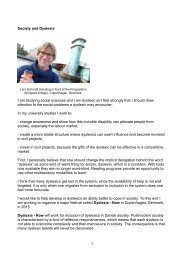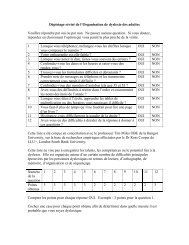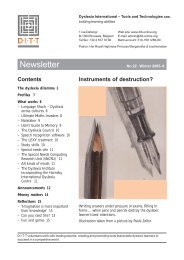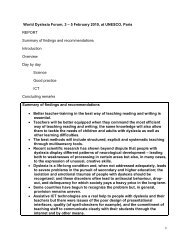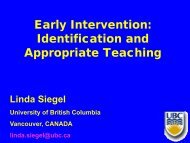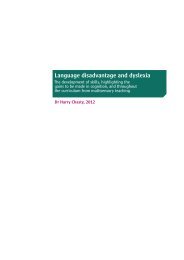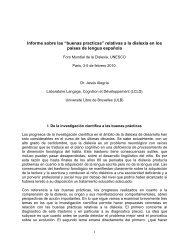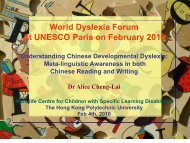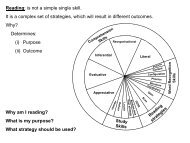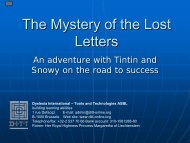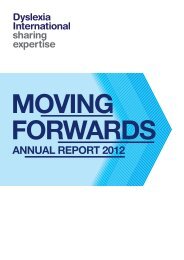Good Practice in interventions for teaching dyslexic learners and in ...
Good Practice in interventions for teaching dyslexic learners and in ...
Good Practice in interventions for teaching dyslexic learners and in ...
- No tags were found...
Create successful ePaper yourself
Turn your PDF publications into a flip-book with our unique Google optimized e-Paper software.
<strong>Good</strong> <strong>Practice</strong> <strong>in</strong> <strong>in</strong>terventions <strong>for</strong> teach<strong>in</strong>g <strong>dyslexic</strong><br />
<strong>learners</strong> <strong>and</strong> <strong>in</strong> teacher tra<strong>in</strong><strong>in</strong>g <strong>in</strong> English‐speak<strong>in</strong>g<br />
countries<br />
Jenny Thomson, Harvard Graduate School of Education<br />
July 2010<br />
1. Are there specific l<strong>in</strong>guistic features of English that might make it more<br />
difficult <strong>for</strong> people with dyslexia to read <strong>and</strong> write<br />
English is known as an orthographically deep language, which means that the<br />
correspondences between sounds <strong>and</strong> symbols are not <strong>in</strong> a 1:1 relationship.<br />
The translation between oral <strong>and</strong> written English is a notoriously unpredictable process,<br />
<strong>for</strong> while written English has rema<strong>in</strong>ed largely unchanged over the centuries, the use of<br />
sounds has evolved significantly, creat<strong>in</strong>g many cases of mismatch between <strong>in</strong>dividual<br />
sounds <strong>and</strong> letters. This results <strong>in</strong> many ways of spell<strong>in</strong>g a s<strong>in</strong>gle sound, <strong>for</strong> example the<br />
long “a” sound can be represented by at least eight different letter patterns: a, a‐e, ai,<br />
ay, eigh, ei, ea, ey. Conversely, a s<strong>in</strong>gle letter can be pronounced multiple ways, <strong>for</strong><br />
example the letter ‘a’ <strong>in</strong> the sentence, He was carefully plant<strong>in</strong>g all the cabbages<br />
carefully around the many potatoes. The high <strong>in</strong>cidence of both these types of<br />
<strong>in</strong>consistency <strong>in</strong> English 1 impact both spell<strong>in</strong>g <strong>and</strong> read<strong>in</strong>g respectively.<br />
Interest<strong>in</strong>gly, while the most obvious unit of consistency to th<strong>in</strong>k about is the <strong>in</strong>dividual<br />
letter or phoneme (the smallest mean<strong>in</strong>gful unit of speech, often correspond<strong>in</strong>g to a<br />
s<strong>in</strong>gle letter e.g. ‘b’ or ‘p’), systematic statistical analyses of English have now<br />
demonstrated that the most predictable level of word analysis is that of onset‐rime 2 .<br />
1
Any syllable can be divided <strong>in</strong>to an onset consonant <strong>and</strong> a rime, the latter conta<strong>in</strong><strong>in</strong>g the<br />
vowel <strong>and</strong> an optional coda, or f<strong>in</strong>al consonant(s), <strong>for</strong> example, c‐ot. Thus, while the<br />
English language system appears to follow few consistent rules at the level of <strong>in</strong>dividual<br />
letters <strong>and</strong> sounds, when consider<strong>in</strong>g larger ‘chunks’, patterns can be found. Given that<br />
these patterns are less obvious <strong>and</strong> often need explicit teach<strong>in</strong>g, achiev<strong>in</strong>g a sense of<br />
mastery <strong>in</strong> read<strong>in</strong>g <strong>and</strong> spell<strong>in</strong>g can be difficult <strong>in</strong> English, especially <strong>for</strong> children with<br />
dyslexia.<br />
2. Literacy <strong>and</strong> Society<br />
In all the English‐speak<strong>in</strong>g countries from which questionnaires were returned, there<br />
was a consensus that literacy is encouraged throughout society. We live <strong>in</strong> times when<br />
knowledge has become the most important <strong>for</strong>m of capital. While economic, social <strong>and</strong><br />
cultural activities are thus deeply dependent upon knowledge <strong>and</strong> <strong>in</strong><strong>for</strong>mation,<br />
acquisition of knowledge <strong>and</strong> <strong>in</strong><strong>for</strong>mation is itself dependent upon literacy.<br />
Yet, it is also important to note the results of <strong>in</strong>ternational reports, such as OECD PISA,<br />
the Programme <strong>for</strong> International Student Assessment 3 which consistently highlights<br />
large gender gaps <strong>in</strong> the read<strong>in</strong>g per<strong>for</strong>mance of 15 year olds across English speak<strong>in</strong>g<br />
countries <strong>and</strong> beyond, with girls consistently outper<strong>for</strong>m<strong>in</strong>g their male peers. Rather<br />
than attribut<strong>in</strong>g these differences to between‐sex bra<strong>in</strong> development differences, which<br />
have not yet yielded consistent relationships to learn<strong>in</strong>g, the report places responsibility<br />
at the level of schools <strong>and</strong> societies who, ”do not always succeed <strong>in</strong> foster<strong>in</strong>g<br />
comparable levels of motivation, <strong>in</strong>terest or self‐confidence <strong>in</strong> different areas among<br />
male <strong>and</strong> female students” (p.48).<br />
There are also disparities <strong>in</strong> literacy provision across the lifespan. As soon as children<br />
enter school, a key goal is learn<strong>in</strong>g to read, to enable lifelong read<strong>in</strong>g to learn.<br />
Accord<strong>in</strong>gly, across countries, significant daily class time is devoted to literacy <strong>in</strong> the<br />
primary grades, teachers accept this as one of their key roles <strong>and</strong> can receive tra<strong>in</strong><strong>in</strong>g<br />
2
<strong>and</strong> resources to help <strong>in</strong> this endeavor. However even two or three years <strong>in</strong>to a child’s<br />
school career, the role of explicit literacy <strong>in</strong>struction dim<strong>in</strong>ishes <strong>and</strong> so <strong>for</strong> students who<br />
are not yet <strong>in</strong>dependent readers the number of teachers who are tra<strong>in</strong>ed to provide<br />
appropriately‐tailored help <strong>and</strong> the number of age‐ <strong>and</strong> skill‐level‐ appropriate teach<strong>in</strong>g<br />
materials decl<strong>in</strong>es. Provision becomes even less consistent <strong>for</strong> adults. While the NCSALL<br />
<strong>in</strong> the United States reports that more than 40 percent of work<strong>in</strong>g‐age adults <strong>in</strong> the<br />
United States lack the literacy skills <strong>and</strong> education needed to succeed <strong>in</strong> family, work,<br />
<strong>and</strong> community life (http://www.ncsall.net/<strong>in</strong>dex.phpid=17) national <strong>in</strong>frastructures<br />
<strong>for</strong> tra<strong>in</strong><strong>in</strong>g adult literacy teachers, provid<strong>in</strong>g professional development <strong>and</strong> clear career<br />
trajectories or even supportive day‐to‐day work<strong>in</strong>g conditions are sorely lack<strong>in</strong>g. With<br />
less research evidence also available concern<strong>in</strong>g best practice <strong>for</strong> adult literacy<br />
<strong>in</strong>struction <strong>and</strong> limited f<strong>in</strong>ancial resources devoted to either the research or practice <strong>in</strong><br />
this area, successful literacy acquisition appears to be the exception as opposed to the<br />
norm.<br />
However, even where f<strong>in</strong>ancial resources are present, allocation constra<strong>in</strong>ts can affect<br />
successful literacy acquisition <strong>for</strong> struggl<strong>in</strong>g readers. Across education systems, schools<br />
<strong>and</strong> districts who are juggl<strong>in</strong>g f<strong>in</strong>ite resources will apply the economics of scale <strong>in</strong> terms<br />
of decid<strong>in</strong>g whether to allocate funds to a school‐wide program that may yield small<br />
ga<strong>in</strong>s across a large number of children, versus provid<strong>in</strong>g <strong>in</strong>dividualized help that may<br />
yield larger ga<strong>in</strong>s, but <strong>for</strong> fewer children.<br />
3. Rights <strong>and</strong> Recognition <strong>for</strong> Individuals with Dyslexia<br />
Across the English‐speak<strong>in</strong>g countries surveyed, rights <strong>and</strong> recognition <strong>for</strong> <strong>in</strong>dividuals<br />
with dyslexia appeared to be very variable. Even with<strong>in</strong> countries, there can be<br />
differential recognition between the medical <strong>and</strong> educational fields, which has<br />
implications <strong>for</strong> the rights accorded to people with dyslexia, <strong>and</strong> how these rights<br />
change over the lifespan.<br />
3
The term “dyslexia” was first co<strong>in</strong>ed <strong>in</strong> 1887 by a German ophthalmologist <strong>and</strong> s<strong>in</strong>ce this<br />
time has undergone many changes of def<strong>in</strong>ition, as well as acceptance. Typically, the<br />
term has been adopted more by medical fields <strong>and</strong> researchers, while decisions<br />
regard<strong>in</strong>g fund<strong>in</strong>g allocations are determ<strong>in</strong>ed by education authorities. The latter tend<br />
to avoid the term dyslexia, with educators <strong>in</strong> North America us<strong>in</strong>g the term ‘specific<br />
learn<strong>in</strong>g disability’ <strong>and</strong> the UK <strong>and</strong> Australia us<strong>in</strong>g the term, ‘specific learn<strong>in</strong>g difficulty’.<br />
However, despite the difference <strong>in</strong> labels, common trends <strong>and</strong> dilemmas of def<strong>in</strong>ition<br />
can be seen across countries. The first dilemma is the usefulness of giv<strong>in</strong>g a child a label<br />
at all. S<strong>in</strong>ce the 70s, the governments of Australia <strong>and</strong> New Zeal<strong>and</strong> have argued aga<strong>in</strong>st<br />
both a <strong>for</strong>mal def<strong>in</strong>ition of learn<strong>in</strong>g disability, as well as aga<strong>in</strong>st categorical fund<strong>in</strong>g <strong>for</strong><br />
those experienc<strong>in</strong>g specific learn<strong>in</strong>g difficulties. Rather, non‐categorical fund<strong>in</strong>g has<br />
been available <strong>for</strong> the very lowest achievers, which has often acted to the disadvantage<br />
of students with specific, not general learn<strong>in</strong>g difficulties.<br />
In North America, federal recognition of specific learn<strong>in</strong>g disabilities, which <strong>in</strong>cludes<br />
dyslexia, is well‐established, <strong>and</strong> <strong>for</strong> school children, legal recognition is <strong>in</strong>tricately<br />
connected with entitlement to extra services (Individuals with Disabilities Education<br />
Improvement Act, 2004). These services will either be geared at remediation of the core<br />
read<strong>in</strong>g difficulties <strong>for</strong> younger students, with an <strong>in</strong>creas<strong>in</strong>g emphasis on compensation<br />
<strong>for</strong> older students, such as use of a word process<strong>in</strong>g, learn<strong>in</strong>g study skill strategy to<br />
bypass read<strong>in</strong>g difficulties.<br />
In adults, legal recognition provides less rights to remedial help, but rather is geared<br />
towards prevention of discrim<strong>in</strong>ation <strong>in</strong> employment or access to everyday services.<br />
Examples <strong>in</strong>clude the Disability Discrim<strong>in</strong>ation Act (DDA) 1995 <strong>in</strong> the UK, The Americans<br />
with Disabilities Act of 1990.<br />
4
4. Assessment Procedures <strong>for</strong> Dyslexia<br />
Across the countries surveyed, no country had a s<strong>in</strong>gle, agreed upon metric <strong>for</strong><br />
identify<strong>in</strong>g dyslexia. One reason <strong>for</strong> this is that we know from the research that dyslexia<br />
is not a discrete entity. The phonological difficulties associated with dyslexia are present<br />
on a cont<strong>in</strong>uum <strong>and</strong> so the choice of what is a “significant” problem is necessarily<br />
arbitrary.<br />
A consensus on the key elements of a <strong>for</strong>mal assessment are the need to assess:<br />
a) phonological process<strong>in</strong>g skills, <strong>in</strong>clud<strong>in</strong>g phonological awareness, phonological<br />
memory <strong>and</strong> rapid nam<strong>in</strong>g<br />
b) read<strong>in</strong>g <strong>and</strong> spell<strong>in</strong>g skills, ideally across s<strong>in</strong>gle word <strong>and</strong> connected text levels<br />
c) wider cognitive skills <strong>and</strong> developmental history, to rule out other explanations <strong>for</strong><br />
the literacy difficulties.<br />
A widely‐used, yet controversial criteria <strong>for</strong> identification has been the discrepancy<br />
criteria: i.e. a significant discrepancy between a child’s wider cognitive skills or potential,<br />
as measured by an IQ test, <strong>and</strong> their read<strong>in</strong>g ability. However, while relatively clear, this<br />
criteria means that many children have to fail <strong>for</strong> long enough to get a diagnosis, a very<br />
unsatisfactory situation when we know that early <strong>in</strong>tervention is an optimal strategy.<br />
An emerg<strong>in</strong>g alternative criteria <strong>in</strong> the US <strong>and</strong> UK is a diagnosis based on the Pr<strong>in</strong>ciples<br />
of Response‐to‐Intervention (RTI). In this scenario dyslexia is def<strong>in</strong>ed by significant <strong>and</strong><br />
unexpected read<strong>in</strong>g difficulties that are not respond<strong>in</strong>g to the provision of evidencebased<br />
practice, with no stipulation of an IQ‐read<strong>in</strong>g discrepancy. This strategy def<strong>in</strong>itely<br />
holds promise, questions also rema<strong>in</strong> to be clarified <strong>in</strong>clud<strong>in</strong>g how do we measure<br />
students’ responsiveness to an <strong>in</strong>tervention, what <strong>in</strong>terventions are used, how much<br />
responsiveness is ‘enough’ By gett<strong>in</strong>g rid of the discrepancy criteria, dist<strong>in</strong>guish<strong>in</strong>g<br />
students with specific versus general learn<strong>in</strong>g disabilities become less clear.<br />
5
5. Effective Teach<strong>in</strong>g Methodologies <strong>for</strong> Dyslexia<br />
a) Content<br />
Key features of best practice <strong>for</strong> content teach<strong>in</strong>g:<br />
I) explicit tra<strong>in</strong><strong>in</strong>g <strong>in</strong> phonological awareness<br />
II) strong focus on phonological decod<strong>in</strong>g <strong>and</strong> word‐level work<br />
III) supported <strong>and</strong> <strong>in</strong>dependent read<strong>in</strong>g of progressively more difficult texts<br />
IV) practice of comprehension strategies while read<strong>in</strong>g texts<br />
Major reviews of early read<strong>in</strong>g <strong>in</strong>struction <strong>for</strong> both classroom‐wide success as well as<br />
specialist teach<strong>in</strong>g <strong>for</strong> <strong>in</strong>dividuals with dyslexia concur that the key features of teach<strong>in</strong>g<br />
read<strong>in</strong>g at the earliest stages are that it is multi‐sensory <strong>and</strong> phonologically based 4,5 . At<br />
the core of dyslexia is a phonological deficit <strong>and</strong> so this must be addressed.<br />
The idea of multi‐sensory phonics is not at all new, <strong>and</strong> is derived from the pr<strong>in</strong>ciples<br />
pioneered by Orton, Gill<strong>in</strong>gham <strong>and</strong> Stillman <strong>in</strong> the 1920s <strong>and</strong> 30s. It <strong>in</strong>volves the<br />
simultaneous l<strong>in</strong>k<strong>in</strong>g of visual, auditory <strong>and</strong> k<strong>in</strong>esthetic <strong>in</strong><strong>for</strong>mation to enhance memory<br />
<strong>and</strong> learn<strong>in</strong>g. Key resources <strong>for</strong> f<strong>in</strong>d<strong>in</strong>g out more about multi‐sensory approaches are<br />
shown <strong>in</strong> the box below.<br />
6
Phonics program resources<br />
International Dyslexia Association:<br />
http://www.<strong>in</strong>terdys.org/InsInt.htm<br />
Offers a matrix compar<strong>in</strong>g multisensory read<strong>in</strong>g programs<br />
Florida Center <strong>for</strong> Read<strong>in</strong>g Research (FCRR):<br />
www.fcrr.org<br />
Provides reports of read<strong>in</strong>g programs <strong>and</strong> their research‐base<br />
What Works Clear<strong>in</strong>ghouse:<br />
www.ies.ed.gov/ncee/wwe<br />
Collects <strong>and</strong> reviews empirical research on educational products<br />
The Center on Instruction:<br />
www.centeron<strong>in</strong>struction.org<br />
A US site provid<strong>in</strong>g resources <strong>in</strong>clud<strong>in</strong>g research reports on educational products<br />
<strong>for</strong> read<strong>in</strong>g, math, science, special education, <strong>and</strong> English language learn<strong>in</strong>g<br />
Best Evidence Encyclopedia:<br />
www.bestevidence.org<br />
Created by the Johns Hopk<strong>in</strong>s University School of<br />
Education’s Center <strong>for</strong> Data‐Driven Re<strong>for</strong>m <strong>in</strong> Education, USA<br />
Canadian Language <strong>and</strong> Literacy Network:<br />
http://www.cllrnet.ca/<br />
7
) Process<br />
Key features of best practice <strong>for</strong> teach<strong>in</strong>g process:<br />
1. Phonetic<br />
2. Multisensory<br />
3. Cumulative & Sequential<br />
4. Small, Scaffolded Steps<br />
5. Insure Automatization Through <strong>Practice</strong> <strong>and</strong> Review<br />
6. Provide Mental Model<strong>in</strong>g<br />
7. Provide Opportunities <strong>for</strong> Success<br />
Perhaps the best way to elaborate on the optimal teach<strong>in</strong>g process is to exam<strong>in</strong>e the<br />
practices of successful specialist schools <strong>for</strong> <strong>in</strong>dividuals with dyslexia. Many such schools<br />
exist across English‐speak<strong>in</strong>g countries <strong>and</strong> the Benchmark school is highlighted here,<br />
Pennsylvania, U.S.A, largely due to the very explicit ways its practice has been outl<strong>in</strong>ed<br />
<strong>in</strong> a published article, <strong>in</strong>clud<strong>in</strong>g details about the school organization, admissions policy,<br />
staff<strong>in</strong>g, environment, curricula <strong>and</strong> ethos. The article 6 can be downloaded here:<br />
http://www.msularc.org/docu/benchmark.pdf<br />
6. Teacher Knowledge<br />
The importance of teacher knowledge was someth<strong>in</strong>g that came out clearly from the<br />
questionnaires as an area of need. Across English‐speak<strong>in</strong>g countries, classroom<br />
teachers reported feel<strong>in</strong>g unconfident about how to detect a child at risk of dyslexia <strong>and</strong><br />
vary<strong>in</strong>g accessibility to specialist support.<br />
A useful resource to emerge this year comes from the Rose report 5 , published <strong>in</strong> the UK.<br />
In terms of teacher knowledge the report advocates <strong>for</strong> a 3 tier system, as summarized<br />
below.<br />
8
Rose Report: www.dcsf.gov.uk/jimrose<strong>and</strong>dyslexia<br />
Rose recommends that basic teacher education should at a m<strong>in</strong>imum enable classroom<br />
teachers to know the key risk signs of dyslexia, <strong>and</strong> know where to seek advice on what<br />
steps are needed to help them. An example of such <strong>in</strong><strong>for</strong>mation is available on the<br />
British Dyslexia Association Site: http://www.bdadyslexia.org.uk/aboutdyslexia/schools‐colleges‐<strong>and</strong>‐universities/primary‐h<strong>in</strong>ts‐<strong>and</strong>‐tips.html.<br />
This work<strong>in</strong>g<br />
knowledge should be a normal constituent of <strong>in</strong>itial teacher tra<strong>in</strong><strong>in</strong>g of those dest<strong>in</strong>ed<br />
to teach beg<strong>in</strong>ner readers, <strong>and</strong> updated through <strong>in</strong>‐service tra<strong>in</strong><strong>in</strong>g. Rose then<br />
recommends that with<strong>in</strong> every school there should be one teacher who has the<br />
expertise to select literacy <strong>in</strong>terventions, as well as implement, monitor <strong>and</strong> evaluate<br />
them. F<strong>in</strong>ally, there should exist a tier of highly specialist teachers, who play a role <strong>in</strong><br />
tra<strong>in</strong><strong>in</strong>g other teachers, monitor<strong>in</strong>g the implementation of programs <strong>and</strong> devis<strong>in</strong>g<br />
tailored programs <strong>for</strong> specific children.<br />
As well as teacher knowledge, the questionnaires also highlighted the more general<br />
importance of teachers be<strong>in</strong>g cheerleaders <strong>for</strong> this group of students with dyslexia, <strong>for</strong><br />
9
whom the experience of learn<strong>in</strong>g may have conta<strong>in</strong>ed more ef<strong>for</strong>t <strong>and</strong>/or<br />
disappo<strong>in</strong>tment than their typically‐read<strong>in</strong>g peers. Factors commonly identified as<br />
conducive to learn<strong>in</strong>g were:<br />
• Ensur<strong>in</strong>g success. Creat<strong>in</strong>g achievable, mutually‐agreed upon learn<strong>in</strong>g<br />
goals to create a positive sense of self‐efficacy, which <strong>in</strong> turns <strong>in</strong>creases<br />
the amount of future ef<strong>for</strong>t a student is will<strong>in</strong>g to expend <strong>in</strong> literacyrelated<br />
tasks.<br />
• Increas<strong>in</strong>g motivation through literacy materials/activities that connect to<br />
a student’s <strong>in</strong>terests or functional needs.<br />
• Teacher beliefs. Both teachers <strong>and</strong> students reported the learn<strong>in</strong>g<br />
potential engendered when a teacher believes <strong>and</strong> demonstrates a<br />
certa<strong>in</strong>ty that progress is possible, <strong>and</strong> celebrates progress as it occurs.<br />
• Teacher validation of student learn<strong>in</strong>g style. By accept<strong>in</strong>g the current<br />
student’s way of learn<strong>in</strong>g a climate of trust is established that helps<br />
facilitate positive change.<br />
• Explicit model<strong>in</strong>g of successful learn<strong>in</strong>g strategies. Many practitioners<br />
reported that model<strong>in</strong>g <strong>for</strong> a student the strategies <strong>and</strong> processes<br />
<strong>in</strong>volved <strong>in</strong> achiev<strong>in</strong>g their next learn<strong>in</strong>g goal allowed students to<br />
gradually <strong>in</strong>ternalize these steps, grow<strong>in</strong>g as <strong>in</strong>dependent <strong>learners</strong> <strong>in</strong> the<br />
process.<br />
• Positive learn<strong>in</strong>g environments<br />
• Timely feedback<br />
7. Dyslexia <strong>and</strong> Inter‐Agency Collaboration<br />
Across countries, cross‐agency collaboration around dyslexia appears to be <strong>in</strong>consistent,<br />
unless legally required <strong>in</strong> order to meet the needs of specific students, where such laws<br />
are <strong>in</strong> place (e.g. USA <strong>and</strong> UK).<br />
10
For example, <strong>in</strong> the UK <strong>and</strong> elsewhere, at the level of the <strong>in</strong>dividual child, if a significant<br />
learn<strong>in</strong>g need is identified, professional teams collaborate when develop<strong>in</strong>g<br />
<strong>in</strong>terventions <strong>and</strong> programm<strong>in</strong>g <strong>for</strong> <strong>dyslexic</strong> <strong>learners</strong>. These teams are typically<br />
comprised of parents, teachers, mental health workers, health professionals,<br />
educational specialists <strong>and</strong> speech language therapists. The exact degrees of<br />
collaboration, however, vary from county to county, depend<strong>in</strong>g on the degree of<br />
fund<strong>in</strong>g, the sources of fund<strong>in</strong>g (which professionals are funded by education vs. health<br />
services) <strong>and</strong> identification criteria <strong>for</strong> eligible students. Where collaborations appear to<br />
work best is where time is actively allocated <strong>in</strong> schedul<strong>in</strong>g <strong>for</strong> jo<strong>in</strong>t goal‐sett<strong>in</strong>g <strong>and</strong><br />
relationship build<strong>in</strong>g, which builds mutual trust, ensur<strong>in</strong>g a basic level of shard<br />
knowledge around read<strong>in</strong>g difficulties <strong>and</strong> ongo<strong>in</strong>g progress check<strong>in</strong>g.<br />
At the level of communities, districts <strong>and</strong> nations, a message that emerged was the<br />
powerful impact of non‐governmental organizations <strong>in</strong> facilitat<strong>in</strong>g collaborative<br />
solutions to address the educational needs of <strong>dyslexic</strong> <strong>learners</strong>. In the US, <strong>for</strong> example,<br />
the International Dyslexia Association (which also has ten global partners <strong>in</strong> Austria,<br />
Brazil, Czech Republic, Germany, Great Brita<strong>in</strong>, India, Irel<strong>and</strong>, Israel, Japan, Kuwait,<br />
Latvia, The Philipp<strong>in</strong>es <strong>and</strong> S<strong>in</strong>gapore) effectively focuses resources on provid<strong>in</strong>g<br />
<strong>in</strong><strong>for</strong>mation, support<strong>in</strong>g research, professional development as well as advocacy <strong>and</strong><br />
public policy.<br />
11
Summary<br />
• Intensive, multi‐sensory systematic phonics <strong>in</strong>struction should<br />
be at the heart of dyslexia <strong>in</strong>tervention<br />
• Early identification is critical, <strong>and</strong> teacher preparation should<br />
facilitate this<br />
• Dyslexia can have serious effects on an <strong>in</strong>dividual’s wider<br />
academic, social <strong>and</strong> emotional development: atta<strong>in</strong>able goals<br />
<strong>and</strong> expectation of success are key<br />
References<br />
1. Ziegler, J.C., Stone, G.O. & Jacobs, A.M. What is the pronunciation <strong>for</strong> ‐ough <strong>and</strong> the<br />
spell<strong>in</strong>g <strong>for</strong> /u/ A database <strong>for</strong> comput<strong>in</strong>g feed<strong>for</strong>ward <strong>and</strong> feedback consistency <strong>in</strong><br />
English. Behavior Research Methods, Instruments & Computers 29, 600‐618 (1997).<br />
2. Treiman, R., Mullennix, J., Bijeljac‐Babic, R. & Richmond‐Welty, E.D. The special role of<br />
rimes <strong>in</strong> the description, use, <strong>and</strong> acquisition of English orthography. Journal of<br />
Experimental Psychology: General 124, 107‐136 (1995).<br />
3. OECD. Equally prepared <strong>for</strong> life How 15‐year‐old boys <strong>and</strong> girls per<strong>for</strong>m <strong>in</strong> school.<br />
(OECD, Paris, 2009).<br />
4. NICHD. Report of the National Read<strong>in</strong>g Panel. Teach<strong>in</strong>g children to read: An evidencebased<br />
assessment of the scientific research literature on read<strong>in</strong>g <strong>and</strong> its implications <strong>for</strong><br />
read<strong>in</strong>g <strong>in</strong>struction: Reports of the sub‐groups. (U.S. Government Pr<strong>in</strong>t<strong>in</strong>g Office,<br />
Wash<strong>in</strong>gton, DC, 2000).<br />
5. Rose, J. Identify<strong>in</strong>g <strong>and</strong> teach<strong>in</strong>g children <strong>and</strong> young people with dyslexia <strong>and</strong> literacy<br />
difficulties. (Department <strong>for</strong> Children, Schools <strong>and</strong> Families<br />
London, UK, 2009).<br />
6. Pressley, M., Gask<strong>in</strong>s, I.W., Solic, K. & Coll<strong>in</strong>s, S. A Portrait of Benchmark School: How a<br />
School Produces High Achievement <strong>in</strong> Students who Previously Failed. Journal of<br />
educational psychology 98, 282 (2006).<br />
12
Acknowledgements<br />
With thanks to the follow<strong>in</strong>g questionnaire respondents:<br />
Simona Craciun, M<strong>in</strong>istry of Education, Research <strong>and</strong> Innovation, ROMANIA<br />
Nheang Saroeun, M<strong>in</strong>istry of Education Youth <strong>and</strong> Sport, CAMBODIA<br />
Michael Asefaw Tesfamichael, Special Needs Education Services, ERITREA<br />
Bence Kas, Eötvös Loránd University of Sciences, HUNGARY<br />
Kristiant<strong>in</strong>i Dewi Soegondo, Pediatrician, INDONESIA<br />
Phyllis Wamucii M. Kariuki, Private Consultant of Dyslexia, KENYA<br />
Nazri Latiff, MALAYSIA<br />
Aili Hashim, University of Malaya, MALAYSIA<br />
SpLD Service & M<strong>in</strong>istry of Education, MALTA<br />
Astrid Bos, Policy maker <strong>in</strong> central government, THE NETHERLANDS<br />
Pro Futuro, LATVIA<br />
A<strong>in</strong>slie So’o ‐ M<strong>in</strong>istry of Education, Sports <strong>and</strong> Culture, SĀMOA<br />
Siripakka Dhamabus, Office of Basic Education Commission, THAILAND<br />
Sue Webb, Bredon school, UK<br />
S<strong>and</strong>ra Agombar, Calder House School, UK<br />
Sue Cleary, UK<br />
Mrs Robertson, Kilgraston School, UK<br />
Marilyn Cook, Teacher <strong>and</strong> District Dyslexia Specialist, USA<br />
Dovey Kasen, Special Education Teacher, USA<br />
Therese Filk<strong>in</strong>s, USA<br />
Renee Langmuir, Read<strong>in</strong>g Specialist, St. Joseph’s University, USA<br />
Angela Swift, Special Education Teacher, USA<br />
Shelley Ball‐Dannenberg, Dyslexia Test<strong>in</strong>g & In<strong>for</strong>mation Services, LLC, USA<br />
13



